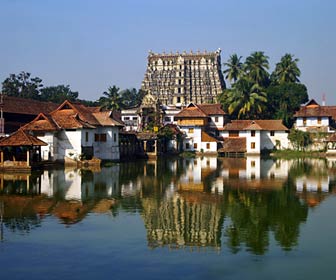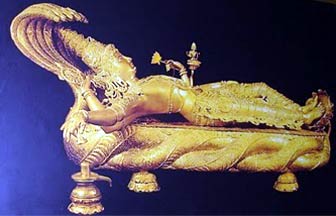Padmanabha Swamy Temple
 |
|
|
Padmanabha Swamy TemplePadmanabha Swamy Temple at Thiruvananthapuram is one of the important Hindu temples of India. The temple is dedicated to Lord Padmanabha or Vishnu. The temple is regarded as one of the 108 Divya Desams or Vishnu Kshetrams (main centers of worship of the god in Vaishnavism). The temple is administered by a trust supervised by the royal family of Travancore.  The temple has been built in the Dravidian style of architecture with 7 tiers Gopuram (entrance tower). The Gopuram has been built in Pandyan style. The Temple is a similar to the famous Sri Adikesavaperumal Temple at Thiruvattar. The capital of Kerala state, Thiruvananthapuram got its name because of this Padmanabha Swamy Temple situated in this place. 'Thiru' 'Anantha' 'Puram' literally means Sacred Abode of Lord Anantha Padmanabha. The temple has been built in the Dravidian style of architecture with 7 tiers Gopuram (entrance tower). The Gopuram has been built in Pandyan style. The Temple is a similar to the famous Sri Adikesavaperumal Temple at Thiruvattar. The capital of Kerala state, Thiruvananthapuram got its name because of this Padmanabha Swamy Temple situated in this place. 'Thiru' 'Anantha' 'Puram' literally means Sacred Abode of Lord Anantha Padmanabha.The chief deity of Padmanabha Swamy Temple is Lord Padmanabhaswamy, is enshrined in the 'Anantha-Sayanam' posture (in the deep sleep of Yoga-Nidra on his serpent Anantha). The King of Travancore accepts the title as, 'Sree Padmanabha-dasa' (literally means Slave of Lord Padmanabhaswamy). Legend of Padmanabha Swamy Temple, Thiruvananthapuram It is believed that Sage Vilvamangalathu Swamiyar alias Divakara Muni who stayed near Ananthapuram Temple in Kasargod prayed to Lord Vishnu for his appearance. The Lord pleased from the prayer and appeared in disguise like a small, naughty boy. The boy degraded the Saligrama that was kept for Pooja. The Sage turned angry for this then chased the boy. The boy vanished. Then the Sage arrived at Ananthan kadu looking for the boy. Here the sage noticed the boy merging with an Iluppa tree (Indian Butter Tree). The tree collapsed and turned to Anantha Sayana Moorti (Vishnu reclining on Anantha). However the Lord was in the very big in size with head at Thiruvallom, navel at Thiruvanananthapuram and lotus-feet at Thrippadapuram (Thrippappur). The Sage asked the Lord to reduce in size to a lesser size - three times the length of his body. Instantly, the Lord reduced his. But even at that time numerous Iluppa trees obstructed an entire image of the Lord. The Sage viewed the Lord in three parts - thirumukham, thiruvudal as well as thrippadam. The Ananthan Kadu Nagaraja Temple still exists towards the north west of Sri Padmanabhaswamy Temple. The Samadhi (last resting spot) of Sage exists towards the west of Sri Padmanabha Temple. A Temple dedicated to lord Krishna was constructed over the Samadhi. This Temple, generally known as Vilvamangalam Sri Krishna Swami Temple, belongs to Thrissur Naduvil Madhom. The temple of Padmanabha swamy, Thiruvananthapuram  Inside sanctum sanctorum, the main deity Lord Padmanabha swamy is in the sleeping posture on his serpent Anantha or Adi Sesha. The serpent has five hoods facing inwards, signifying contemplation. The right hand of Lord Padmanabha swamy is placed over a Shiva lingam. Sridevi, the Deity of Wealth and Bhudevi the Deity of Earth, two wives of Lord Vishnu are by his side. Lord Brahma emerges on the lotus, that originates from the navel of Lord Padmanabha. The statue of deity is created from 12,000 saligramams. These Saligramams are from the banks River Gandaki in Nepal, also to celebrate this some rituals was once carried out at the Pashupatinath Temple. The statue of Sri Padmanabha is protected with, "Katusarkara yogam", a special Ayurvedic mixture, that forms a plaster that retains the deity clean. Inside sanctum sanctorum, the main deity Lord Padmanabha swamy is in the sleeping posture on his serpent Anantha or Adi Sesha. The serpent has five hoods facing inwards, signifying contemplation. The right hand of Lord Padmanabha swamy is placed over a Shiva lingam. Sridevi, the Deity of Wealth and Bhudevi the Deity of Earth, two wives of Lord Vishnu are by his side. Lord Brahma emerges on the lotus, that originates from the navel of Lord Padmanabha. The statue of deity is created from 12,000 saligramams. These Saligramams are from the banks River Gandaki in Nepal, also to celebrate this some rituals was once carried out at the Pashupatinath Temple. The statue of Sri Padmanabha is protected with, "Katusarkara yogam", a special Ayurvedic mixture, that forms a plaster that retains the deity clean.The Temple consists of two other important shrines, Thekkedom and Thiruvambadi, dedicated for the Deities, Sree Yoga Narasimha and Sree Krishna Swami respectively. The Padmanabhaswamy Temple stands by the side of a tank, named Padma Theertham (literally means the lotus spring). Temple Entry and Dress Code As per the Temple Entry policy, only those who follow the Hindu faith are allowed inside the temple. Devotees must strictly follow the dress code. Festivals of Padmanabhaswamy Temple The most important festivals are bi-annual. The Alpashy festival which is in October/November and the Painkuni festival which is in March/April and it last for 10 days each. On the ninth day the Maharajah of Travancore escorts the deities to the Vettakkalam for Pallivetta. Another major annual festival celebrated at Padmanabha temple is the Navaratri festival. The major festival in this temple is Laksha Deepam, literally means lighting one hundred thousand lamps. This festival is only one of its kind and celebrated once in 6 years. Prior to this festival, chanting of prayers and recitation of three vedas is done for 56 days. On the last day, hundred thousand oil lamps are lit in and around the temple premises. Treasure at Padmanabhaswamy Temple, Thiruvananthapuram An estimated $20 billion and counting in gold, diamonds, statues and other valuables have been discovered in the secret rooms of Padmanabhaswamy Temple making it the richest temple in the world. The incredible treasure trove was stored for approximately 140 years among five vaults in the Sree Padmanabhaswamy Temple at Thiruvananthapuram. Kollam: 65 Km Kottayam: 166 Km Kumarakom: 175 Km Alappuzha: 151 Km Ernakulam: 212 Km Idukki: 235 Km Thrissur: 280 Km Munnar: 322 Km Kozhikode: 403 Km Thalassery: 472 Km Wayanad: 481 Km Kannur: 491 Km Kasargod: 584 Km How to get there: Nearest Airport: Thiruvananthapuram International Airport (IATA: TRV, ICAO: VOTV) Nearest Railway Station: There are five railway stations within the city limits including the Thiruvananthapuram central station. Thiruvananthapuram Pettah, Kochuveli, Veli stations and Thiruvananthapuram Nemom are other railway stations. Road: Thiruvananthapuram is well connected by road network. The National Highway NH-47 runs from Salem to Kanyakumari, passes through the city. It connects important southern cities such as Coimbatore and Salem in north direction and Nagercoil in south direction. Kerala State RTC operates daily bus service from Thiruvananthapuram to the other cities of the state. Enquiry Form
Please send us your enquiry and we will respond within 24 to 48 hours. |
Terms of Use | Disclaimer | Privacy Policy
© 2017 - www.KeralaTourismHotels.com - All Rights Reserved. Padmanabha Swamy Temple